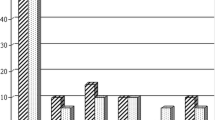Abstract
Background
Degenerative spondylolisthesis of the cervical spine is rare. Patients show signs of progredient myelopathy, radiculopathy and pain. Treatment strategies include ventral, dorsal and combined fusion techniques with or without repositioning and decompression.
Methods
In this study, we present 16 patients with degenerative cervical spondylolisthesis. The leading symptom was severe myelopathy in 8 patients, radiculomyelopathy in 5 patients and neck pain in 3 patients. However, neck pain was the initial symptom in all the patients and decreased when neurological symptoms became more evident. Radiographic examinations included plain radiography, MRI, CT, myelography and lateral tomography.
Results
Spondylolisthesis was located five times at level C3/4, C4/5 and C5/6. In three cases spondylolisthesis was located at level C7/T1. There were two patients with spondylolisthesis on two levels. Instability could be demonstrated by flexion/extension radiography in five cases. Patients were divided into three groups according to a newly introduced classification system. The surgical approach corresponded to this classification. In ten patients the spondylolisthesis could be corrected by extension and positioning, so discectomy and fusion on one or two levels with cage, plate and screws was sufficient. In five cases a corpectomy was necessary due to severe spondylosis. In one case a combined approach with dorsal decompression and release followed by ventral fusion was applied due to additional dorsal spinal cord compression. The follow-up period was 6–52 months. After surgery, none of the patients showed any signs of neurological deterioration. In all cases, a stable fusion was achieved with no signs of instability on flexion/extension radiographs. Neurological improvement was seen in 6 of 8 patients with myelopathy and 4 of 5 patients with radiculomyelopathy. The others showed stable disease. Pain relief was seen in all patients who complained of pain preoperatively.
Conclusion
The aims of treatment for cervical spondylolisthesis are spinal cord decompression (ventral, dorsal or both), correction and fusion. The used procedure should depend on the severity of the cervical deformity, degree and side of the spinal cord compression, and the possibility of correction by extension and positioning.
Similar content being viewed by others
References
Boulos AS, Lovely TJ (1996) Degenerative cervical spondylolisthesis: diagnosis and management in five cases. J Spinal Disord 9: 241–245
Deburge A, Mazda K, Guigui P (1995) Unstable degenerative spondylolisthesis of the cervical spine. J Bone Joint Surg Br 77: 122–125
Eleraky MA, Llanos C, Sonntag VK (1999) Cervical corpectomy: report of 185 cases and review of the literature. J Neurosurg 90: 35–41
Fujimura Y, Nishi Y, Chiba K, Kobayashi K (1995) Prognosis of neurological deficits associated with upper cervical spine injuries. Paraplegia 33: 195–202
Goffin J, Grob D (1999) Spondyloptosis of the cervical spine in neurofibromatosis. A case report. Spine 24: 587–590
Hacker RJ, Cauthen JC, Gilbert TJ, Griffith SL (2000) A prospective randomized multicenter clinical evaluation of an anterior cervical fusion cage. Spine 25: 2646–2654
Holmes A, Wang C, Han ZH, Dang GT (1994) The range and nature of flexion-extension motion in the cervical spine. Spine 19: 2505–2510
Kirkaldy-Willis WH, Wedge JH, Yong-Hing K, Reilly J (1978) Pathology and pathogenesis of lumbar spondylosis and stenosis. Spine 3: 319–328
Lee C, Woodring JH, Rogers LF, Kim KS (1986) The radiographic distinction of degenerative slippage (spondylolisthesis and retrolisthesis) from traumatic slippage of the cervical spine. Skeletal Radiol 15: 439–443
Odom GL, Finney W, Woodhall B, Durham NC (1958) Cervical disc lesions. JAMA 166: 23–28
Penning L (1978) Normal movements of the cervical spine. AJR Am J Roentgenol 130: 317–326
Postacchini F, Perugia D (1991) Degenerative lumbar spondylolisthesis. Part I: etiology, pathogenesis, pathomorphology, and clinical features. Ital J Orthop Traumatol 17: 165–173
Sy MH, Marouf OC, Sene P, Diouf S, Seye SI (1998) [Cervical spondylolisthesis in skeletal fluorosis. A case report]. Int Orthop 22: 407–409
Tani T, Kawasaki M, Taniguchi S, Ushida T (2003) Functional importance of degenerative spondylolisthesis in cervical spondylotic myelopathy in the elderly. Spine 28: 1128–1134
Author information
Authors and Affiliations
Corresponding author
Rights and permissions
About this article
Cite this article
Woiciechowsky, C., Thomale, U.W. & Kroppenstedt, S.N. Degenerative spondylolisthesis of the cervical spine — symptoms and surgical strategies depending on disease progress. Eur Spine J 13, 680–684 (2004). https://doi.org/10.1007/s00586-004-0673-9
Received:
Revised:
Accepted:
Issue Date:
DOI: https://doi.org/10.1007/s00586-004-0673-9




